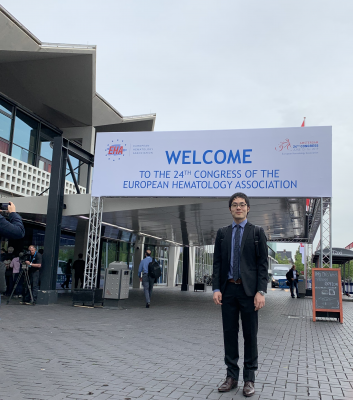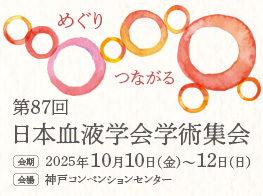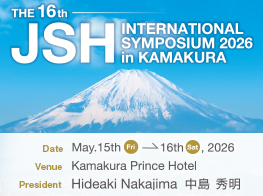
名前:清木 祐介【筑波大学 血液内科】
発表日時:2019年6月15日
発表形式:Poster
Title:
Targeting T-cell receptor signaling pathway by dasatinib in relapsed/refractory angioimmunoblastic T-cell lymphoma
Authors:
Yusuke Kiyoki 1, 2, Mamiko Sakata-Yanagimoto 1, 2, 3, Tran B. Nguyen 1, Manabu Fujisawa 1, Yasuhito Nannya 4, Kantaro Ishitsuka 1, Haruka Momose 1, Shinichiro Sukegawa 3, Atsushi Shinagawa 5, Takuya Suyama 5, Yuji Sato 6, Hidekazu Nishikii 1, 2, 3, Naoshi Obara 1, 2, 3, Manabu Kusakabe 1, 2, 3, Seishi Ogawa 4, and Shigeru Chiba 1, 2, 3
Affiliations:
1. Graduate School of Comprehensive Human Sciences, University of Tsukuba
2. Department of Hematology, University of Tsukuba Hospital
3. Department of Hematology, Faculty of Medicine, University of Tsukuba
4. Department of Pathology and Tumor Biology, Graduate School of Medicine, Kyoto University
5. Department of Hematology, Hitachi General Hospital
6. Department of Hematology, Tsukuba Memorial Hospital
Abstract:
Background: Angioimmunoblastic T-cell lymphoma (AITL) is an intractable T-cell lymphoma. The recurrent hotspot (p.Gly17Val) mutations in RHOA encoding a small GTPase, together with the loss-of-function mutations in TET2 encoding an epigenetic regulator, are the genetic hallmark in AITL. We previously identified that the p.Gly17Val RHOA mutant hyperactivates T-cell receptor (TCR) signaling through direct binding to VAV1, a component of the TCR pathway. VAV1 mutations were also found in RHOA-negative AITL cases. The phosphorylation of VAV1 induced by the RHOA binding or its own amino acid changes was effectively inhibited by dasatinib at low concentrations. Dasatinib also prolonged the survival of AITL model mice (ASH 2017). Here, we performed a phase I clinical trial of dasatinib monotherapy in relapsed/refractory AITL patients.
Methods and Results: Five patients (one male and four females; 51-72 y/o; median, 65 y/o) being diagnosed with AITL were enrolled. Written informed consent was obtained from all the patients. The median number of prior chemotherapies was 2 (range, 1-5). Two patients (Patient 1 and 2) were refractory to the latest chemotherapies. One patient (Patient 3) relapsed after the autologous transplantation. The performance status was 0-2. Dasatinib was started at a dose of 100 mg/body q.d. and continued until days 10-78 (median day 58). Patient 2 withdrew the consent on day 10 and thus the response was not evaluable. In the remaining four patients, dasatinib was continued until day 54 or later and the response evaluation was possible. The trial was ultimately discontinued due to further treatment with allogeneic hematopoietic stem cell transplantation, disease progression, or severe adverse event in these four patients. Grade3/4 adverse drug reactions were observed in one case (Patient 5). The other adverse events were attributable to exacerbation of the diseases. There were no new safety concerns other than reported in BCR-ABL-positive chronic myelogenous leukemia/acute lymphoblastic leukemia. The maximum response was partial responses (PR) in all these four patients. The response at the discontinuation of trial was PR in two (Patient 1 and 5) and progressive disease (PD) in two (Patient 3 and 4).
Targeted sequencing using a panel for 427 genes identified 34 candidate mutations including 22 nonsilent single nucleotide variants (SNVs), 2 nonsense mutations, 3 frameshift deletions, 2 frameshift insertions, 2 nonframeshift deletions, and one nonframeshift insertion. Two TET2 mutations were found in 4 samples (PAT1, PAT2, PAT4, and PAT5). The Gly17Val RHOA mutations were found by targeted sequencing in 2 samples (PAT3 and PAT4). VAV1 mutations were found in 2 samples (PAT2 and PAT5). Additionally one tandem duplication involving VAV1 locus was also identified by manual inspection of Integral Genome Viewer (IGV) in PAT5.
Conclusion: AITL is highly dependent on TCR signaling, and dasatinib appears to be a promising candidate treatment modality in AITL.
EHA2019参加レポート
この度は24th Congress of European Hematology Association(EHA)への参加にあたり,日本血液学会EHA Travel Awardに御採択いただきありがとうございました。今回のEHAはオランダ首都アムステルダムで2019年6月13日から6月16日の計4日間開催されました。学会開催期間中のアムステルダムの気候はやや悪く,雨が降ったり止んだりしておりました。時折肌寒さが感じられましたが,夕焼け時にCentraal Stationから見える街並みや運河はとても美しいものでした。今回は私にとって初めてのEHAの参加となりました。参加人数は12,000人を超え,セッション数はさほど多くはないものの,基礎・臨床ともに内容は濃く,どのセッションにおいても盛り上がりを見せておりました。
私は今回,再発難治性血管免疫芽球性T細胞リンパ腫(AITL)患者に対するダサチニブ単剤治療の第Ⅰ相臨床試験の結果を報告いたしました。我々の研究室では過去にAITLにおいて,RHOA遺伝子のホットスポット(G17V)変異を同定し,また,G17V変異RHOA蛋白質とVAV1蛋白質が結合し,VAV1のリン酸化を介してT細胞受容体(TCR)シグナルを異常活性化することを報告しております。さらに,VAV1リン酸化はLCKやFYNなどのチロシンキナーゼによって担われ,これらはダサチニブの良い標的であり,ダサチニブがRHOA(G17V)変異によるTCRシグナル増強反応を低濃度で抑制し,AITLモデルマウスではダサチニブにより生存期間の延長がもたらされることを見出しました。これら一連の知見に基づき,我々は再発難治性AITLに対するダサチニブ単剤治療の第Ⅰ相臨床試験を行いました。患者は計5名が参加しました。同意撤回をされた1例を除き,追跡可能であった4例全例で部分奏効が得られ,既存の報告にない新規の副作用は認めませんでした。TCRシグナルを標的とした本治療が今後のAITLに対する治療戦略に組み込まれることが期待できる結果であったと考えております。
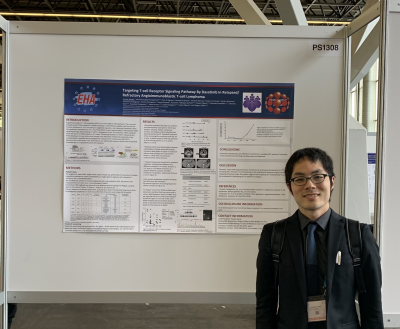
T細胞リンパ腫に関する演題はoral,posterともに数が限られておりました。しかし,その中でも今回の我々の報告に対して多くの方々が興味を持っていただき,議論を交わすことができ,大変密度の濃い時間となりました。
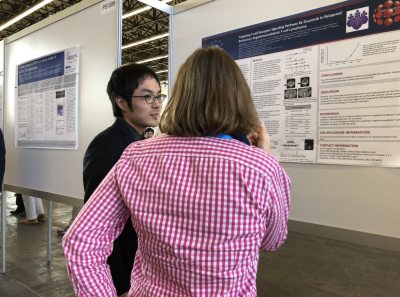
他の発表については,数々の新規分子標的薬やCAR-T療法を中心としたがん遺伝子治療・免疫療法に関する臨床試験の報告が盛んに行われており,日本では未承認の薬剤が多いながらも治療選択肢が凄まじい勢いで増加していることを実感いたしました。また,clonal hematopoiesisやagingに関するセッションは非常に盛り上がっており,ほぼ満席となっておりました。agingによる造血細胞変化や,骨髄微小環境のremodelingなどについても,基礎から臨床のデータまで,最新の知見が要約されており,充実した内容でした。個人的には,末梢血のスメア像を機械学習させることにより末梢血像からclonal hematopoiesisが推測できないか試みている報告は興味深いものでした。基礎研究,臨床ともに国際的な知見を,演者より直接得ることができ,貴重な経験となりました。今後の自身の研究・臨床に活かしていきたいと思います。
最後に,このような貴重な機会を与えていただきました日本血液学会国際委員会,事務局の皆様に心より感謝いたします。また,日々臨床・研究ともにご指導をいただいている千葉滋教授,坂田麻実子先生をはじめ,お世話になっている先生方,また,今回の臨床試験にご協力をいただきました各施設の先生方にこの場をお借りして感謝申し上げます。
